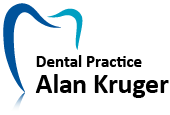
Orthodontic Braces for Crooked Teeth Dental Practice Alan Kruger
Orthodontics deals with the recognition and correction of crooked teeth...
Orthodontics deals with the recognition and correction of crooked teeth and the improper biting position of the jaws.
Orthodontic treatment helps to reposition the patient's teeth, line them up in the right place, and change the way the upper and lower jaws meet. Crooked teeth are important to recognise and treat at an early age because with time, it can lead to tooth decay (cavities) and gum disease.
Nearly 30% of the population present with crooked teeth severe enough to benefit from orthodontic treatment. Nowadays, adults also want straight teeth, even though they missed the chance when they were younger. Due to advanced techniques with braces, adults can also have straight teeth through modern orthdonic procedures.
Orthodontic treatment can focus on crooked teeth only, or deal as well with the control and modification of growth of the jaws. For comprehensive orthodontic treatment, metal wires are inserted into orthodontic brackets ("braces") glued to the teeth. The braces can be made from stainless steel or a more aesthetic ceramic material. The wires interact with the braces to move teeth into the desired positions. The braces cannot be removed, and are glued permanently onto the teeth.
Aligner trays or splints may be used instead of brackets ("braces"). These are clear plastic trays which move the teeth. The trays are removable, and worn only temporarily at nighttime.
Functional appliances are often used to modify and redirect jaw growth. These are removable temporary appliances (orthodontic plates, headgear and expansion apparatus). This kind of treatment is most beneficial in a young growing patient (age 5 to 14). These appliances are removable, and worn only temporarily at nighttime. This functional appliance therapy, is frequently followed by fixed multi-bracket therapy ("braces") to align the teeth.
After a course of active orthodontic treatment to move teeth, patients will always wear passive orthodontic retainers to help keep the teeth in their new improved positions, while the surrounding jawbone adapts around the tooth to the new position. The passive retainers are worn full-time for a period up to to a year, then part-time (typically, nightly during sleep) for a few years after active orthodontic treatment.
